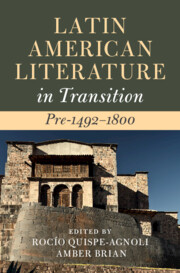Book contents
- Latin American Literature in Transition Pre-1492–1800
- Latin American Literature in Transition
- Latin American Literature in Transition Pre-1492–1800
- Copyright page
- Dedication
- Contents
- Figures
- Contributors
- Acknowledgments
- Introduction Dwelling in Transitions
- Part I Land, Space, Territory
- Part II Body
- Chapter 5 The Health of the Soul: Religious Guidance and Medical Practice in Early Colonial Mexico
- Chapter 6 Viceroy Valero’s Heart: A Traveling Relic and an Embodied Metaphor in Transit to the Indies
- Chapter 7 Humoralism and Colonial Subjugation: Indians and Medical Knowledge in the Sixteenth and Seventeenth Centuries
- Chapter 8 Assaulted Bodies: The Case of Two Enslaved Black Women in the Port City of Santa María de los Ángeles de Buenos Aires, 1772–1778
- Part III Belief Systems
- Part IV Literacies
- Part V Languages
- Part VI Identities
- Index
- References
Chapter 6 - Viceroy Valero’s Heart: A Traveling Relic and an Embodied Metaphor in Transit to the Indies
from Part II - Body
Published online by Cambridge University Press: 25 November 2022
- Latin American Literature in Transition Pre-1492–1800
- Latin American Literature in Transition
- Latin American Literature in Transition Pre-1492–1800
- Copyright page
- Dedication
- Contents
- Figures
- Contributors
- Acknowledgments
- Introduction Dwelling in Transitions
- Part I Land, Space, Territory
- Part II Body
- Chapter 5 The Health of the Soul: Religious Guidance and Medical Practice in Early Colonial Mexico
- Chapter 6 Viceroy Valero’s Heart: A Traveling Relic and an Embodied Metaphor in Transit to the Indies
- Chapter 7 Humoralism and Colonial Subjugation: Indians and Medical Knowledge in the Sixteenth and Seventeenth Centuries
- Chapter 8 Assaulted Bodies: The Case of Two Enslaved Black Women in the Port City of Santa María de los Ángeles de Buenos Aires, 1772–1778
- Part III Belief Systems
- Part IV Literacies
- Part V Languages
- Part VI Identities
- Index
- References
Summary
This chapter analyzes the sermon given by Francisco de la Concepción Barbosa (1729) in the funeral rites for the heart of Baltasar de Zuñiga, marquis of Valero (1658-1727) and Viceroy of New Spain from 1716 to 1722. Once he returned to Spain, he arranged that, after his death, his heart would be embalmed and buried in the high altar of the Corpus Christi Franciscan convent for the Indian Cacicasthat he founded in Mexico in 1719 and was authorized by Luis I in 1724. It studies two aspects of the colonial discourse of the funeral for the heart: (a) its symbolic and emblematic context, as an imaginary relic that aspires to immortality beyond the corruption and fragmentation of the body; and (b) its historical context, in connection to the case of Bishop Fernandez de Santa Cruz, who also donated his heart to the convent of Santa Monica in Puebla (1699).
Keywords
- Type
- Chapter
- Information
- Latin American Literature in Transition Pre-1492–1800 , pp. 93 - 106Publisher: Cambridge University PressPrint publication year: 2022



